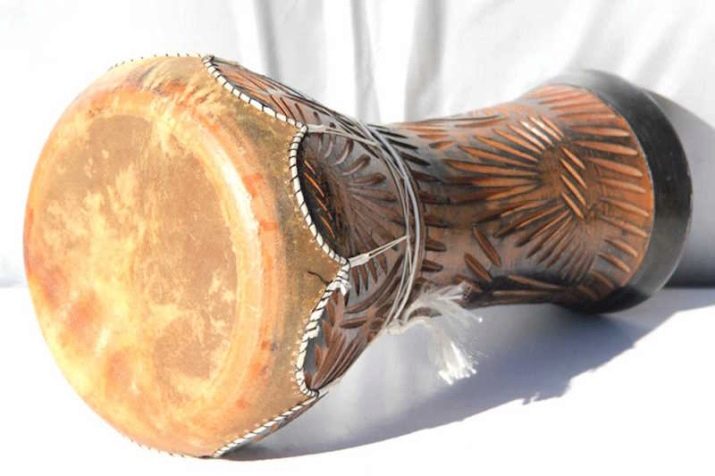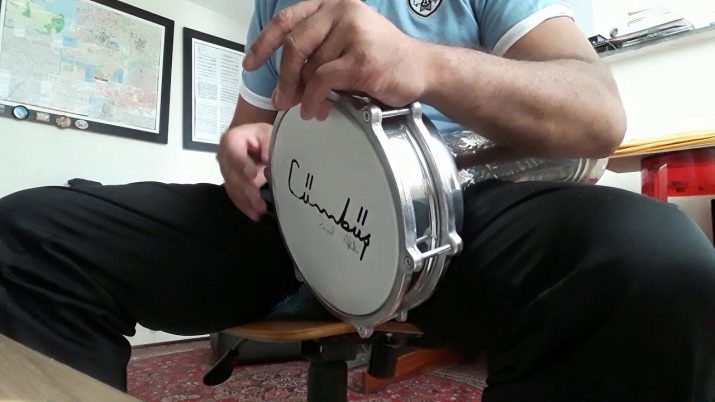All about the musical instrument darbuka

Darbuka is an ancient percussion instrument that came to us from the Middle East and North Africa. The sound is extracted from it by blows, clicks, shaking.

What it is?
The Darbuka is a compact cone-shaped percussion instrument with roots dating back to the late Neolithic. His images and descriptions were found in many sources of the cultural heritage of the countries of Europe, Transcaucasia, Africa, and the Middle East.

Every nation has a miniature ethnic cone-shaped drum with its own name: in Egypt - tabla, in Iran - tonbak, in Syria - derbekki, in India - tumbaknari. At some point in history, Europeans lost interest in it, and for several millennia it dropped out of our culture. Today we consider the darbuka to be an exotic oriental instrument.

Initially, the drum was made of baked clay; the skin of animals or fish was used as a membrane. Today, modern materials are involved in the production of tools, but at the same time traditional products are also produced.

The eastern peoples have always had a respectful, almost sacred attitude to the darbuka. The drum took part in ritual ceremonies, at weddings and funerals, in fighting rings. It could be heard in everyday life - in bazaars and squares, since a small instrument is easily carried to the place of events.

Both in the past and today, ethnic oriental dances are sung and danced to the darbuka. Modern musicians of the European and American continent began to use it during the performance of jazz, rock, blues, Latin American music.

Structure
The cup-shaped drum at the ends contains a hole, one of them (wide) is covered with a membrane.It is fixed to the body in different ways. The traditional clay version is most often connected to the leather upper with ropes woven into a mesh.

A bolt ring holds the plastic diaphragm to the metal tool.
The outer connection is inherent in Turkish drums, the Egyptian products contain hidden fasteners.

The height of the instrument is not the same for different peoples and can range from 35 to 60 centimeters. The diameter of the membrane is to some extent related to the height of the drum; its size varies from 22 to 32 cm.
The sound of a darbuka is influenced by the size, material and width of the neck - the narrower it is, the lower the sounds produced. Boomy deep bass is created by air resonance, similar to the hum of a bottle cavity with a narrow throat.


The variety of drum names is associated not only with ethnicity, but also with the difference in sound. For example, the Egyptian tabla refers to the solo drum, the dohalla refers to the bass instrument, and the sumbati occupies an intermediate position between them.

As for the material, in addition to traditional clay, the following raw materials are used for the manufacture of the hull.
- Metal - aluminum, copper, brass. The drum uses a synthetic material in the form of a thin springy plastic as a membrane. The products are good as everyday household tools. They are resistant to cold and humid climates, which products made from natural materials cannot boast of. On metal drums, bolts are used to adjust the sound, they are responsible for the voltage level of the membrane.
Such models are not capricious, strong and durable.

- Hardwoods - maple, walnut, birch, apricot, bubing (mahogany) - used for the housing in combination with a membrane made of pet leather. Wooden drums are used in Arab ceremonies and ethnic festivals.

- Ceramics - has a firing rate of 1000 degrees, becomes a caked monolithic and very durable material. It is akin to ancient clay. These instruments are covered in leather and have an amazing thick sound. They are used to reproduce rhythms from the stages of large concert halls.

- Fiberglass - The drums contain a synthetic mylar membrane and mechanical tunings. These are lightweight and durable products with a pretty decent sound. They are made in Canada and the USA by combining fiberglass with wood. The American company "Remo", trying to improve its products and bring artificial membranes closer to the composition of natural leather, has learned to produce a material with unusual sensitive fibers.

Depending on the material, the body of the darbuka is decorated with glaze, engraving, wood carving, and chasing.
It should be noted that instruments made from natural materials are sensitive to moisture.
A leather membrane in a humid environment (fog, cloudy evening) damp and stretches, loses its sonorous rich sound. Fish skin is less susceptible to changes, but it also requires drying. In the past, drums were dried by an open fire; today, other sources of heat are sought. Some manufacturers place light bulbs in the housing. Products with plastic membranes never lose their elasticity.

Views
Darbuka is of great importance for many peoples of the Middle East, North-West Africa, some countries of Southern Europe, and each ethnic community sees this instrument in its own way, brings a piece of its own culture into its image.
- Greeks have their own drum (tubeleki) decorated in the form of an amphora, its booming sound is particularly soft.

- Egyptian tabla has beveled edges, which allows smooth lines to emphasize the harmony and integrity of the instrument.

- Clear circumference of the Turkish drumreinforced with steel hoops and bolts, makes the appearance of the product sharp, dynamic, it seems that such an instrument is able to beat out endless rhythmic fractions.

- Moroccans choose snakeskin for the membrane of their tarij. To make the instrument sound more varied, a special string is installed in the inside of the drum.

- In Iraq, kshishba has an elongated shape and resembles a pipemade of wood. The small diameter membrane is made of fish skin.

- Afghan zirbakhali comes with an additional element on the membrane that allows the sound to vibrate.

Of all the abundance of goblet drums belonging to different nationalities, two large groups can be distinguished - Egyptian and Turkish. Let's dwell on them in more detail.
Turkish
Turkish darbuka for everyday use is made of metal, usually copper. Synthetic leather is used as a membrane. The sharp edges are framed by steel rings with bolts to tighten the diaphragm. The tool is convenient because it is easy to customize.

The diameter of the upper part of Turkish products varies from 20 to 29 cm. During the game, the drum is kept close at hand or rests on the leg, a snapping technique is used for the game. With the help of the palms and fingers of the instrument, up to 50 different sounds can be extracted from the instrument, but the range of metal products remains narrow.

Another thing is durable ceramic darbuks with a leather membrane. For their manufacture, the highest quality clay is mined in the ancient city of Izmir. Under the influence of Egypt, Turkish clay drums began to be produced with sloping edges. They are easily distinguished by their size, which is much larger than their African counterparts.

To get rid of moisture, a heating lamp is installed inside the drum.
The sound of Turkish ceramic instruments is more diverse and sophisticated than the Egyptian versions. They are used to perform exquisite chamber music in concert halls.

Egyptian
This version of the tapered drum contains rounded edges, it has no external screw settings, so the model looks solid, with soft smooth lines. Egyptians divide their darbuks into three types in terms of size and sound: the largest is called dohola, the middle one is sumbati, and a small model is called tabla.

Ceramics and wood are used as the material for the body, and goat or calf skin is used for the membrane. Factory-made metal products became widespread among Egyptian and Syrian musicians. They are made by casting from aluminum. The thickness of the tool is precisely calculated, in the right places it becomes thinner to 1 cm.

The case is decorated with appliqués, mother-of-pearl mosaics or mahogany fragments. Then they are covered with several coats of varnish for durability and shine.
Egyptian drums are indispensable when accompanying oriental dances. The beveled edges facilitate the rolling of the fingers, speed up the rhythm, but make it softer, without the pronounced clicking movements that are produced using Turkish darbuk.

Subtleties of the game
In Russia, there are schools for learning to play the Arabic drum, in which novice musicians can touch with their own hands a wonderful oriental instrument, beat out beautiful rhythms, and feel exotic, enchanting sounds.

Position
Darbuka refers to compact drums. Its weight allows not only to carry the product with ease, but also to hold it in different positions during the game.
- Sitting: the instrument is placed on the lap, holding it with one hand. You can also place the drum in a seated position between your knees and grip it firmly.
- In a standing position, the darbuka is pressed to the body from the side. At this moment, the safety strap is thrown over the musician's shoulder.
- With the drum on your shoulder, it is quite possible to play while standing or move around the stage.


The darbuka is played with two hands, where the right one is dominant and knocks out the main rhythm, and the left one leads the background melody. It is allowed to play with the hands and the çubuk stick.This method of extracting sounds from a drum is often found among the gypsies of the Middle East.

Technique
On an Arabic drum, two tones are considered basic:
- low, reproducible when hitting the central part of the instrument;
- high, obtained from edge impacts on the membrane.

But the professionalism of the musicians allows you to extract many rhythmic sounds from a miniature drum. They can be in the form of a ringing and prolonged hum or a multiple tremolo tremolo. The player slides his hands over the surface, makes sounds with resounding clicks of his fingers or dull slaps of his palms. In addition, he hits the body or uses hand claps.

Some darbuk models contain removable metal sagata inside the body, enriching the sound with a silvery tinkle.
The rhythmic, mesmerizing sounds made tapered drums incredibly popular. But few remember today that this musical instrument actually came to us from the Bronze Age and became an integral part of the culture of many nations.









